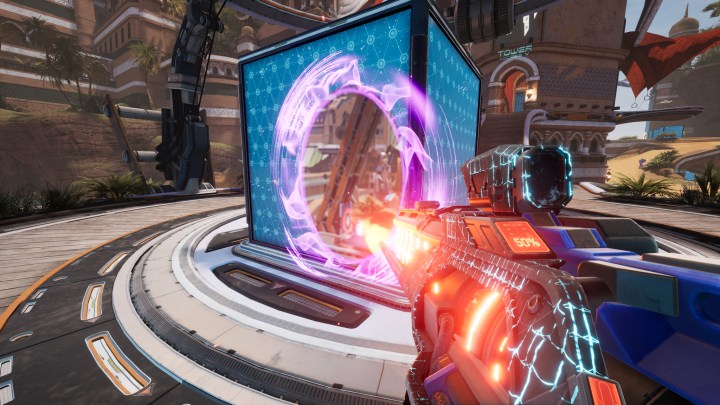While I’m not great at first-person shooters. I’m not terrible either — I can hold my own in a casual playlist — but I generally get squashed in a ranked game of Overwatch or Destiny 2’s Trials of Osiris. I have a lot of skills in my gaming toolset, but precise aiming and lightning-fast reaction times have just never been my strong suit. I’m more of a puzzle game guy who thrives when I can take a second to think about a situation and build a clever solution.
That’s why I love Splitgate. It’s a shooter for people who can’t keep up in most competitive shooters.
Thinking with portals
Splitgate is a first-person, free-to-play shooter by 1047 Games that’s best described as “Halo meets Portal” (an overused descriptor that’s entirely accurate in this case). Everything from the shooting, modes, and level design feels heavily inspired by games like Halo 2, making it feel like a love letter to the Bungie days of the series.
There’s an important twist on the formula, though: Portals. In Splitgate, players can place portals on blue surfaces, allowing them to travel long distances in the blink of an eye. Nearly 15 years following the release of Portal, it’s still an exciting trick that only feels more impressive in the context of a multiplayer game. There are few things more satisfying in the shooter genre right now than sniping someone across the map through a well-placed portal.

It’s not just a random gimmick dropped on top of a perfectly good formula. The portal mechanic makes Splitgate more approachable to players who don’t quite have the speed to compete in games like Valorant. It’s less about being able to land a perfect headshot and more about using spatial reasoning to outwit an enemy. It’s a rare shooter that prioritizes clever play over technical skill.
Here’s a concrete example of that design philosophy. In one round, I found myself running up a narrow hallway. As I got halfway up, an enemy rounded the corner ahead of me, with one of their friends tailing close behind. In any other shooter, I’d be dead in seconds. There’s no way I’d survive a two-on-one confrontation, especially with my superhuman ability to only land body shots. If I wanted to survive, I’d need a clever escape plan. It just so happened that there was a blue wall behind my approaching enemies. I quickly shot out a portal, turned, and placed another on a wall directly next to me. That wall happened to be a blind spot for my opponents. From their perspective, I ran behind a corner to hide like a coward.
Imagine their surprise when I popped up behind them and got an unlikely double kill instead.
Great example of this in action. Here's a situation where normally, I would just lose! Running up a narrow hallway, two enemies about to round the corner and outgun me. Instead, I'm able to not only get out of the situation, but actually reverse it entirely! (feat. @JoeHasSpoken) https://t.co/mMWu4EoRI1 pic.twitter.com/yoxqIZBUnd
— Giovanni Colantonio (@MarioPrime) August 29, 2021
Changing the rules
What makes that moment especially satisfying is that it changes the established genre rules I’ve known my entire life. This is a shooter scenario I’ve come across countless times in dozens of games and it always ends the same way. In Splitgate, it doesn’t have to. Any disadvantage can transform into an advantage, and any newcomer can make a seasoned genre veteran look like a chump.
In another notable moment, I found myself in an obnoxious stalemate against another player. We were sniping at each other with carbines from afar. Whenever one of us would hit low health, we’d duck behind a corner and wait for our health to regenerate. Generally, I always lose shootouts like this as I’m rarely going to out-aim an opponent. Instead of hoping my pot shots landed, I shot a portal on a wall above my foe, ducked into cover, and placed a portal. I was suddenly looking directly down at them at close range. I switched to an assault rifle and took them out before they could even look up.
Moments like that are what make Splitgate so enticing. Portals allow players to approach shootouts the same way they’d tackle a puzzle game like Superhot. Every encounter has a potential solution that goes beyond “aim better, shoot faster.” A crafty player can get the drop on someone more “skilled” than them by utilizing some well-placed portals. Hours of guided reading and YouTube research aren’t necessary to stay competitive; experimentation is the current meta.
Like all shooters, I’m expecting Splitgate to get much less friendly to new players as the skill ceiling rises. I imagine that pros will learn how to utilize portals in jaw-droppingly creative ways that counter all my best-laid plans, much like how Fortnite’s building quickly became an exercise in futility for casual players. But for now, I’m just thrilled to play a shooter that doesn’t solely reward the player with the quickest thumbs. Splitgate makes me feel smart in a competitive world that has disintegrated my confidence for decades.
Splitgate is currently free to play on PC, Xbox One, Xbox Series X/S, and PlayStation 4 and 5.


